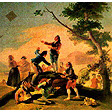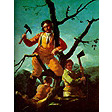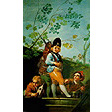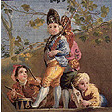
Tapestry manufacturing
Artistic techniques







 |
Tapestry is a kind of textile fabric decorated with polycrhome scenes, whose drawing is wholy integrated into itself, so that it is formed at the same time as the fabric itself. The figurative themes or secenes are copied from a model or catoon created by a painter, which the weaver uses to make the tapestry. Tapestry has a decorative function, imitating a painting. It is intended to be hung, though with the changes in fashion it ended being framed. The base of the loom is the warp. It is a set of paralel threads streched lengthwise. On it, colourful threads are passed reproducing the cartoon decoration. Each decorative passing is followed by another of cotton thread that constitutes the proper weft of the fabric. Inmediately afterwards, a new passing of colorful threads is done, followed by another one of cotton, an so on. The tapestry background is usally a taffeta fabric. Tapestry confection is a manual, very slow task. For it, two kinds of looms are used. The simplest model is the high-warp loom. In it, the warp is stretched vertically; it lacks pedals and the work is drawn in the back of the piece. For helping himself, the weaver usually places a mirrow in front of the tapestry. Thus, he can check how the work is progressing. The cartoon is placed behind, and the general outline of the drawing is sketched on the warp to serve as a guide. The weaver lifts the warp threads with one hand and passes the weft threads between them with the other. Low-warp looms stretch the warp horizontally; threads are separated in two heddles that are operated by two pedals that alternatively lift them up and down, so that the weaver has his both hands free to work with the weft. The cartoon is placed under the warp so that the work is done directly on the model, though seen through the threads of the warp. Work is done in the front of the piece. This technique is faster, so that the performance increases and thus work becomes cheaper, but its results do not equal those of the high-warp loom. At the Real Fábrica de Santa Bárbara, created under Philip V's initiative, work began with low-warp looms in 1720. However, high-warp looms were installed in 1727. Thus, pieces achieved a higher quality and finesse, and their production received a new boom. See alsoBibliographyMaltese, C. (Coord.) Las Técnicas Artísticas. Madrid,1981. Bonet Correa, A. (Coord.) Historia de las Artes Aplicadas e Industriales en España. Madrid, 1982. Marisa Cancela |
|
| Tapestry cartoon, Museo del Prado (Madrid) |  |
|
| Tapestry, Royal Palace of El Escorial (Madrid) |  |
|
| Tapestry cartoon, Museo del Prado (Madrid) |  |
|
| Tapestry, Royal Palace of El Pardo (Madrid) |  |
|
| Tapestry cartoon, Yanduri Col. (Seville) |  |
|
| Tapestry |
 |
InfoGoya 96 is an initiative of the University of Zaragoza, sponsored by the Institution Fernando el Católico of the Deputation of Zaragoza on an Apple Internet Server donated by Apple Computer. |    |